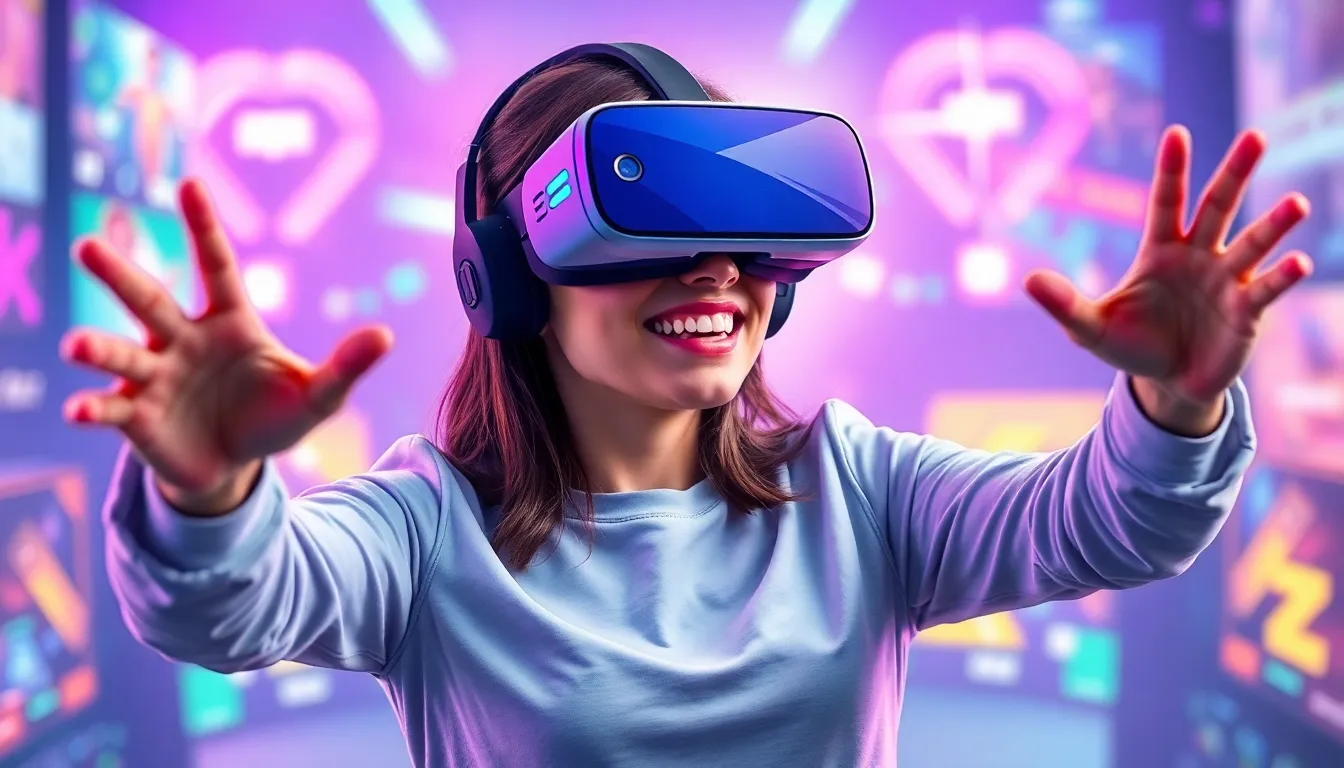Table of Contents
ToggleImagine slipping on a headset and suddenly finding yourself on a tropical beach, sipping a piña colada while lounging with a virtual sloth. Sounds dreamy, right? Welcome to the world of virtual reality, where the line between the real and the imagined blurs faster than you can say “not another Zoom call!”
Overview of Virtual Reality
Virtual reality (VR) represents a computer-generated environment that can simulate real or imagined worlds. Users immerse themselves in these environments through specialized devices, typically VR headsets. Such technology enables interaction within the virtual space, often using controllers or hand-tracking systems.
Key features of VR include sensory feedback and immersion. Environmental sounds and tactile sensations enhance the experience, creating a feeling of being present in the virtual realm. For instance, when a user interacts with a virtual object, the sound or haptic feedback mimics real-world reactions, improving realism.
Applications of virtual reality span multiple industries. In entertainment, gamers experience more engaging gameplay. In education, learners can explore complex subjects, like anatomy or physics, through interactive simulations. Additionally, in healthcare, VR is used for training medical professionals, allowing them to practice procedures in a risk-free environment.
Challenges in the virtual reality sphere involve hardware limitations and user discomfort. High-quality graphics require powerful computers, making accessibility a concern. Furthermore, some users experience motion sickness or eye strain during prolonged use, prompting ongoing research to improve comfort.
The future of virtual reality holds exciting possibilities. Advancements in technology promise higher fidelity graphics and greater accessibility. As VR continues to evolve, integration with augmented reality may enhance collaborative experiences, combining physical and digital elements.
Applications of Virtual Reality

Virtual reality finds extensive applications across diverse fields, enhancing experiences and expanding possibilities.
Gaming and Entertainment
Gaming thrives with virtual reality. Players engage in immersive worlds, moving beyond traditional screens. Notable titles like “Beat Saber” and “Half-Life: Alyx” showcase how VR elevates gameplay experiences. Interaction becomes more dynamic, allowing users to physically engage with the environment. Multiplayer options foster social connections, making gaming more collaborative.
Education and Training
Education transforms through virtual reality. Students access interactive lessons, enhancing their understanding through simulations. Medical training applications, such as “Osso VR,” provide safe environments for future surgeons to practice. History lessons become vivid with immersive experiences that bring past events to life. Employers also leverage VR for employee training, offering realistic scenarios that improve skills and knowledge retention in various fields.
Healthcare Innovations
Healthcare innovations benefit significantly from virtual reality. Therapists utilize VR in treating phobias, creating controlled environments for exposure therapy. Surgical simulations allow surgeons to refine their skills without risk, improving patient outcomes. Additionally, pain management techniques incorporate VR, helping patients distract from discomfort through immersive experiences. Research continues to expand VR’s role, identifying new therapeutic applications in mental health and rehabilitation.
Technology Behind Virtual Reality
Virtual reality relies on advanced technology to create immersive experiences. This technology encompasses hardware components and software development that work together seamlessly.
Hardware Components
Headsets serve as the primary interface for users. Popular options include Oculus Rift, HTC Vive, and Valve Index, each offering distinct features. Motion controllers enhance interaction, allowing users to engage with virtual environments. Tracking systems, like external cameras or sensors, track the user’s position in real-time. High-resolution displays provide crisp visuals, while integrated audio systems deliver realistic sound. These hardware components combine to create an engaging, immersive experience.
Software Development
Software development drives the creation of virtual environments and interactive content. Development platforms, such as Unity and Unreal Engine, enable developers to build VR experiences efficiently. These tools support the integration of graphics, physics, and audio elements. To enhance user interactions, developers often use programming languages like C# or C++. Optimization of performance ensures smooth experiences, reducing latency and enhancing immersion. With continuous advancements, developers create increasingly sophisticated applications tailored for various industries, making VR experiences more engaging than ever.
Benefits of Virtual Reality
Virtual reality offers numerous benefits across various fields. Immersive experiences enhance user engagement significantly. Users can practice complex tasks in safe environments, minimizing real-world risks. For example, surgical training becomes more effective through realistic simulations. Exposure therapy using VR helps patients confront phobias safely.
Entertainment also sees major gains. Gamers enjoy unparalleled immersion in expansive worlds. Titles like “Beat Saber” provide unique interactions that traditional gaming can’t replicate. Social connections flourish within these virtual spaces, allowing players to collaborate and interact seamlessly.
Education transforms with VR, making learning more interactive. Students explore historical events firsthand through simulations, igniting curiosity and enhancing retention. Employers utilize VR for realistic employee training, ensuring better preparedness in real-life scenarios.
Healthcare professionals benefit from VR applications in rehabilitation and pain management. Patients experience distraction through engaging environments, which alleviates discomfort during treatments. Continuous advancements in VR technology further elevate its advantages, making experiences richer and more realistic.
Incorporating VR into everyday life also promotes accessibility. Affordable devices increasingly enable users to access immersive content. Diverse application possibilities enrich experiences, making virtual reality a versatile tool across industries.
Challenges and Limitations
Virtual reality faces several challenges that affect its widespread adoption and effectiveness. Hardware limitations hinder users’ experience; many devices require powerful computers that may not be accessible to everyone. Motion sickness presents another concern; users often experience discomfort during prolonged sessions.
User fatigue occurs as well; extended use of VR headsets may result in eye strain or discomfort. Display technology, while improving, can still lead to visual distortions, impacting immersion. Controllers may present usability issues; intricate designs can overwhelm new users, detracting from the experience.
Accessibility remains a significant barrier; many individuals with disabilities find VR environments challenging to navigate. Content availability presents another limitation; while gaming and educational applications are growing, diverse options across industries are still limited.
Social interaction can feel awkward; even with multiplayer options, users may struggle to connect effectively in virtual spaces. Privacy concerns also arise; users may hesitate to share personal data during VR sessions, limiting data collection necessary for improved experiences.
Cost factors into user adoption; high-quality VR setups may not be financially feasible for many consumers. Lastly, technological fragmentation can confuse developers; various platforms require specific expertise, complicating the creation of universally accessible content.
Addressing these challenges will play a crucial role in the growth and evolution of virtual reality as it aims to provide more inclusive and seamless experiences.
Virtual reality is revolutionizing how people interact with digital content and each other. Its applications span entertainment education and healthcare making it a versatile tool that enhances engagement and learning. As technology continues to advance the experiences offered by VR will become even more immersive and accessible.
Despite the challenges that remain such as hardware limitations and user discomfort the potential for growth in this field is immense. The integration of VR with augmented reality could further enrich collaborative experiences and broaden its appeal. As the industry evolves it promises to reshape not just gaming but various sectors of everyday life.







